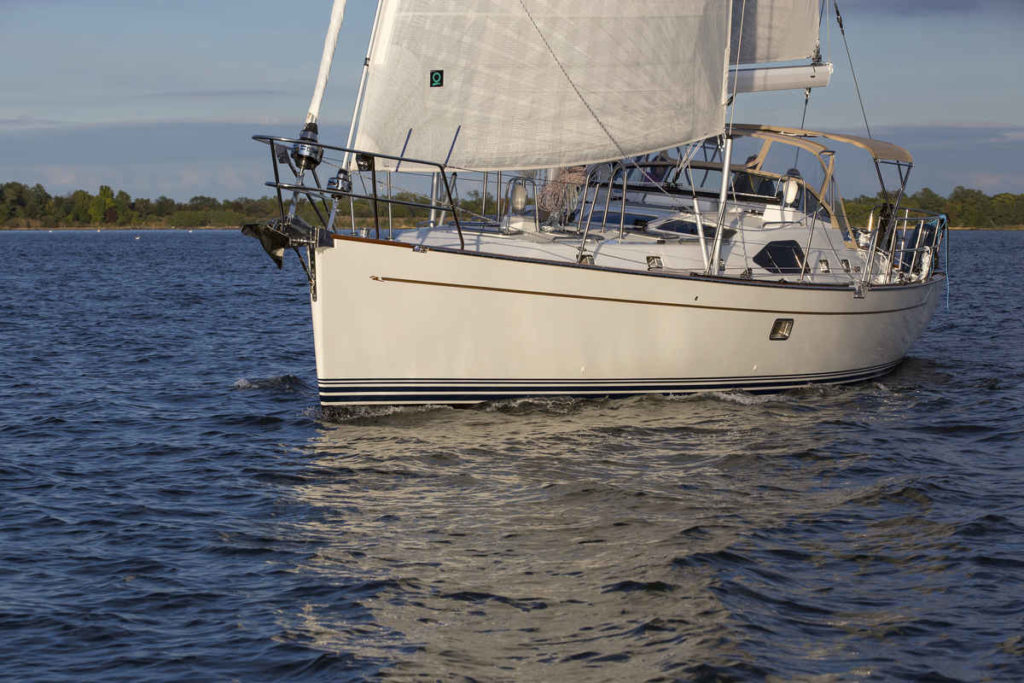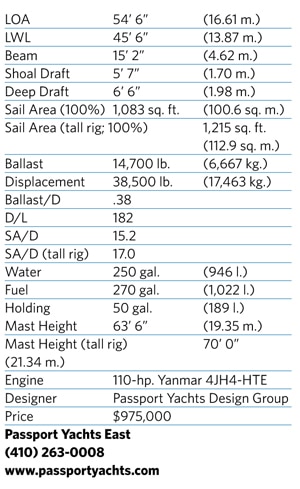
Each fall off Annapolis, Maryland, in the week immediately following the U.S. Sailboat Show, CW‘s Boat of the Year panel takes to the waters of Chesapeake Bay to conduct the sail trials for our Boat of the Year candidates. And every night, while their impressions are fresh, the judges convene for several hours to discuss the merits, and offer their respective opinions, of the boats they’ve put through their paces.
With a price tag in the high six figures, the Passport Vista 545 CC was one of the more expensive yachts in the 2012 fleet of 22 nominees. So, as the director of the contest, I was more than a little surprised at the direction the deliberations took when Alvah Simon—a seasoned, two-time circumnavigator on a pair of relatively modest boats that, together, cost a fraction of what you’d pay for a new Passport—addressed his fellow judges.
“I realize this seems ironic, but I consider this boat a contender for Best Value because there’s that kind of quality and equipment built into it,” said Simon. “The attention to detail is stunning. It’s a piece of art you leave out in the rain.”
His fellow judge, systems expert Ed Sherman of the American Boat & Yacht Council, concurred: “I have to agree with Alvah. The craftsmanship on this boat is amazing. Few boats are put together as well as this one. It’s apparent right down to how the bilges are finished, how the valves are installed—everything. The engine room is mind-blowing. At the end of the day, you’re looking at something that seemingly should be twice as expensive.”
It’s little wonder, then, that when the votes were tallied later that week, the Passport Vista 545 CC was named Cruising World‘s Best Full-Size Cruiser, 45 Feet and Above, for 2012. But let’s delve a little deeper to see precisely what won the judges over.
Passport’s Thom Wagner said the 545, built in China, where the labor costs are low but the workers are highly skilled, took some 32,000 man-hours to create. (That figure alone would’ve pushed the price well above $1 million in a Western boatyard.) Wagner described the construction process thusly: “It’s a solid-glass hull, no core. We use biaxial mat and roving in conjunction with aramid fibers, which are like Kevlar. All of the bulkheads are custom-fit with a CAD machine, so there’s no space between the edge of the bulkhead and the inside of the hull. They’re glassed in all the way around—top, bottom, and sides—so the boat is incredibly rigid.

“The decks are cored,” he continued. “We use two different coring materials—Divinycell in the standard horizontal and vertical surfaces. And in any high-load area, anywhere there’s a winch, windlass, or cleat, we use super-high-density foam along with embedded stainless-steel backing plates. There are no organic cores anywhere in the boat.”
Each Passport is a semicustom design, and while the basic parameters of the 545 CC are established beforehand—the long coach roof, teardrop saloon windows, bulkhead stations, and center cockpit (an aft-cockpit version is also available)—prospective owners have enormous leeway and input into the belowdecks layout and accommodation plan. The exquisite furniture and fittings on our test boat were rendered in American cherry; teak, ash, and other hardwoods are also available.
Cabinetry styles and details are left to the owner, as are the choices for countertops and surface materials (Corian, granite, laminates) and upholstery; Wagner likens it to building a semicustom home. The central floor plan itself was wide open and spacious, highlighted by a pair of sumptuous staterooms fore and aft and a grand saloon that featured a navigation station, U-shaped settee, and main dining table to port and a long straight-line galley to starboard.
The standard, baseline equipment list is lengthy and includes a dodger and bimini, refrigeration, autopilot, compasses, a massive battery bank, a sine-wave inverter, high lifelines, and many other items. The satellite TV, wind generator, and electric primary winches were among the optional extras on our test boat. The hull itself was designed to maximize water length, with a rather blunt entry and a reverse transom that’s recessed and has a built-in swim/boarding step and a fold-down ladder. There’s a large sail locker forward and an extended aft deck, which is nice for lounging and could serve as the stowage space for a tender, though davits are, of course, an option. Below the waterline, the balanced rudder is skeg mounted, and the fin keel is available in three drafts: shoal (5 feet 7 inches in length), standard (6 feet), and deep (6 feet 6 inches).
It perhaps goes without saying, but the purpose of the boat is extended, liveaboard, offshore voyaging and cruising; to that end, the sail plan employs a versatile solent rig with double headsails on furlers (a code zero forward and a working self-tacking jib on the inner forestay) and an in-mast furling mainsail. The Virginia-based owners of our test model chose an ICW-friendly 63-foot-6-inch spar rather than the 70-foot stick.
As we were on the inaugural voyage and the rig hadn’t been tuned and dialed in, we took things easy on our test sail but still managed 7.3 knots hard on the breeze under jib and main in just over 20 knots of apparent wind. The helm was neutral, and the visibility was outstanding. Our one and only small, collective quibble was that, with the exception of the driver, it was hard for our crew of four to get comfortable in the cockpit with the boat heeled and the rail down. On passage, this won’t be an issue for shorthanded crews.
Otherwise, as our judging panel unanimously agreed, the Passport Vista 545 CC is an undisputed winner, and it’s more than ready to tackle the world’s wide waters.
Herb McCormick is CW‘s senior editor.








